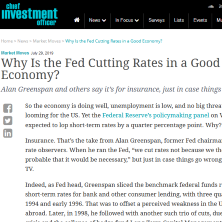 Why Is the Fed Cutting Rates in a Good Economy?
Why Is the Fed Cutting Rates in a Good Economy?
Alan Greenspan and others say it’s for insurance, just in case things go wrong.
So the economy is doing well, unemployment is low, and no big threats appear to be looming for the US. Yet the Federal Reserve’s policymaking panel on Wednesday is expected to lop short-term rates by a quarter percentage point. Why?
Insurance. That’s the take from Alan Greenspan, former Fed chairman, and other interest rate observers. When he ran the Fed, “we cut rates not because we thought that it highly probable that it would be necessary,” but just in case things go wrong, he told Bloomberg TV.
Indeed, as Fed head, Greenspan sliced the benchmark federal funds rate, which affects short-term rates for bank and other consumer lending, with three quarter-point cuts in 1994 and early 1996. That was to offset a perceived weakness in the US economy and abroad. Later, in 1998, he followed with another such trio of cuts, due to the Russian debt crisis and the collapse of hedge fund Long-Term Capital Management.
Of course, that was a different era, when inflation and interest rates were higher: The Consumer Price Index was 2.5% in 1995 and 2.7%, versus 1.6% in 2019, as of June. Meanwhile, the federal funds rate was 6.0% before the 1995 reductions and 5.5% prior to the 1998 easing. Right now, the top of the Fed’s target range is 2.5%.
To critics like Jason Brady, CEO of Thornburg Investment Management, reducing rates now is “stupid.” Pointing to the low unemployment rate (3.7%) and other positive indicators, he asked, “What are we cutting for? We’re solving a problem that doesn’t exist.”
Read more here: https://www.ai-cio.com/news/fed-cutting-rates-good-economy/
